Struck and lost
“Struck and Lost” (S&L) occurs when an animal is hit (struck) by a weapon, such as a rifle bullet, grenade or harpoon, and is not landed. The injured animal may survive or die, depending on the severity of the injury.
Factors that may contribute to reduce S&L
Always have equipment to secure the animal before or after it is killed, such as a harpoon, line and float or a grappling hook.
It is important that equipment is suited to local conditions and maintained in good condition.
Anatomical and physiological features:
- Involuntary reflex movements – especially up and down trashing with flippers and/or tail – can be very violent and last for several minutes.
- The animal’s locomotion ability makes it possible for a seal to slide off the ice, thus it is important to take this into consideration when shooting seals that are lying near the ice edge. A wounded animal can move quickly into the sea.
- Most marine mammals sink when dead or in a state of unconsciousness.
- A thick blubber layer relative to the volume of the animals may make some animals float when dead, while in the opposite case the animals will sink Fat animals float, while thin animals sink. This is the case for seals and smaller toothed whales but not for large whales.
Important to consider these factors before taking a shot/throwing a harpoon/hakapik etc.
Hunters training /experience and technique:
Proper hunting skills and proper hunting techniques are more critical than equipment to hunting success and reducing S&L. Here is a list of the most important aspects to consider:
- Target area (brain, neck, and thorax (heart and lungs) differs from species to species – see attached figures.
- The angel of the shot relative to the longitudinal axis of the whale – do not shoot from behind – see attached figures.
- Shoot when the probability of retrieving he animal is best – i.e. after it has taken a breath so it does not sink.
- To be patient and wait for the right moment to strike an animal.
- Knowledge and training on use of equipment.
- Bullets/grenades are slowed down in water and changes direction.
- In water versus on land/ice.
- Seals: if long shooting distance, the animal may sink before being secured.
- Seasonality, salinity of the water and locality plays a role. For seals: sink easier when body fat content and the salinity of the water is low. River deltas will have less saline water.
Rifle shots in minke whale hunt
Only shoot when whale head is above water. Direct the gunshot to the brain of the animal or the foremost part of the neck region. The site of the brain in minke whale in relation to the outer body characteristics such as eye and blowhole are shown in Fig. 1. If necessary, should the head not emerge from the water, the shot can be aimed at the heart.
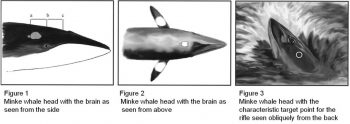
Fig. 1. The brain’s location in the minke whale and target sites for gunshot from different positions. (SK Knudsen, H Rud and EO Øen) Seen from the side, the brain is positioned on a plane mid-way between the eye and dorsal surface of the head. Fig. 1 shows the back edge of the brain laying along a projection on a horizontal line (a) as far behind the eye (b) as the blowhole (c) extends to the front of the eye. The brain of the minke whale is about 20 cm wide, 20 cm long and 15 cm high. The centre of the brain lays about 55 cm back from the blowhole opening in a small (5.5 m) minke whale and about 75 cm back from the blowhole opening in a large (8.5 m) minke whale.
Explosive grenade on large whales
The heart and lungs and their major blood vessels lay in the chest cavity. Above the chest cavity lies the back region with the spinal column that goes up to the brain. These organs are the greatest and most important target region of the animal. Detonation in this region causes the whale to die instantly or in a moment. The grenades are especially made to detonate in the middle of the chest cavity when the shot is directed against the chest and from the side. (Figs. 2 – 5).
Direct the shot from the whaling gun against the chest region and as much as possible from the side

Fig. 2. Minke whale. Vital vulnerability area (hatched area) regarding detonation of a grenade in a minke whale (Balaenoptera acutorostrata). Illustration: S Kessler and EO Øen

Fig. 3. Fin whale. Vital vulnerability area (hatched area) regarding detonation of a grenade in a fin whale (Balaenoptera physalus). Illustration: S Kessler and EO Øen

Fig. 4. Humpback whale. Vital vulnerability area (hatched area) regarding detonation of a grenade in a humpback whale (Megaptera novaeanglia). Illustration: S Kessler and EO Øen

Fig. 5. Bowhead whale. Vital vulnerability area (hatched area) regarding detonation of a grenade in a bowhead whale (Balaena mysticetus). Illustration: S Kessler and EO Øen
Small cetaceans
- The most suitable bullet types for brain shot of small cetaceans are: full metal jacket round nose, solid round nose and solid expanding.
- Different ammunition has dissimilar trajectories. The rifle must therefore always be tested with the ammunition that is employed prior to the hunt.
- Rifle bullets are slowed quickly in water, regardless of the calibre and the weight of the bullet. To ensure that the bullet penetrates the brain, the shot must be fired when the skull is above water.
Species specific target sites
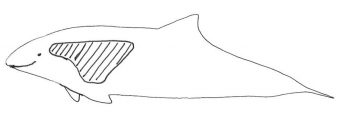
Fig. 6 Harbour Porpoise. The marked area indicates the optimal target area in harbour porpoise. From NAMMCO Expert Group Meeting to Assess the Hunting Methods for Small Cetaceans 15-17 November 2011.
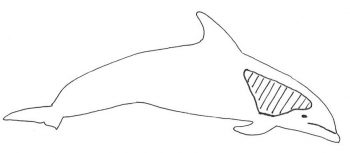
Fig. 7. White-sided and white-beaked dolphins. Due to the larger body-size, calibre .30-06 with full metal jacket bullets are commonly used. The marked area indicates the optimal target area of white beaked and white sided dolphins. From NAMMCO Expert Group Meeting to Assess the Hunting Methods for Small Cetaceans 15-17 November 2011.
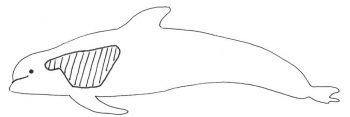
Fig. 8. Long-finned pilot whale. The marked area indicates the optimal target area of a pilot whale. From NAMMCO Expert Group Meeting to Assess the Hunting Methods for Small Cetaceans 15-17 November 2011.
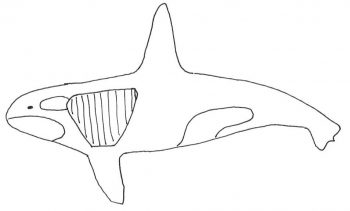
Fig. 9. Killer whale. The marked area indicates the optimal target area of a killer whale. From NAMMCO Expert Group Meeting to Assess the Hunting Methods for Small Cetaceans 15-17 November 2011.
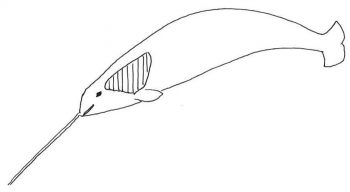
Fig. 10. Narwhal. The marked area indicates the optimal target area of a narwhal. From NAMMCO Expert Group Meeting to Assess the Hunting Methods for Small Cetaceans 15-17 November 2011.

Fig. 11. Beluga. The marked area indicates the optimal target area of beluga. From NAMMCO Expert Group Meeting to Assess the Hunting Methods for Small Cetaceans 15-17 November 2011.


